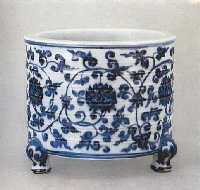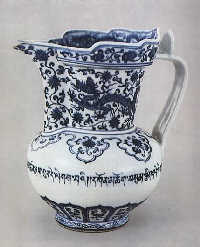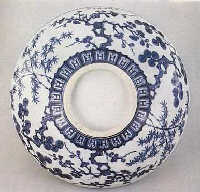 Blue-white porcelain
Blue-white porcelain
 Among all porcelain produced in Jingdezhen, the most representative is blue-white porcelain. Baking blue-white porcelain originated in theNorthern Song Dynasty(960-1127). During the Yuan and Ming dynasties (1271-1644), blue-white porcelain became increasingly popular, and since the 14th century, manufacturers have shipped blue-white porcelain to world markets. The porcelain reached its peak in the Qing Dynasty (1644-1911). Its thin, translucent quality and exotic motifs made it very valuable throughout Europe and the colonies, ranking first among blue-white porcelain nationwide.
Among all porcelain produced in Jingdezhen, the most representative is blue-white porcelain. Baking blue-white porcelain originated in theNorthern Song Dynasty(960-1127). During the Yuan and Ming dynasties (1271-1644), blue-white porcelain became increasingly popular, and since the 14th century, manufacturers have shipped blue-white porcelain to world markets. The porcelain reached its peak in the Qing Dynasty (1644-1911). Its thin, translucent quality and exotic motifs made it very valuable throughout Europe and the colonies, ranking first among blue-white porcelain nationwide.
 Drawing the design with a cobalt pigment onto the stoneware body and painting over it with a transparent glaze creates the blue-white style, also known as "underglazed blue". The piece is then fired at a high temperature. Blue-white porcelain was introduced during theYuan Dynasty(1271-1368) and has been in production ever since thanks to its bright colors, simple yet elegant patterns, and smooth glaze that never fades.
Drawing the design with a cobalt pigment onto the stoneware body and painting over it with a transparent glaze creates the blue-white style, also known as "underglazed blue". The piece is then fired at a high temperature. Blue-white porcelain was introduced during theYuan Dynasty(1271-1368) and has been in production ever since thanks to its bright colors, simple yet elegant patterns, and smooth glaze that never fades.
The Yuan Dynasty is a key period for the development of the firing techniques for blue-white porcelain in China. Its unique characteristics were based on the techniques of former dynasties. Blue-white porcelain had become a major porcelain product in China by the Ming (1368-1644) and Qing dynasties (1644-1911).
Blue-white porcelain had become a major porcelain product in China by the Ming (1368-1644) and Qing dynasties (1644-1911).
Blue-white porcelain of the Yuan Dynasty is large, with a thick roughcast. Generally, the works include big bottles, pots, bowls and plates, with the traditional flavor of the Tang (618-907) and Song (960-1279) dynasties. Due to the underdeveloped techniques, there are two interfaces on the body and several veins inside the body. The roughcast is not as smooth as that of the Ming and Qing dynasties and the glaze is thicker due to more iron in the raw glaze materials.